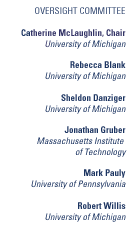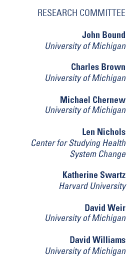|



The University of Michigan
555 South Forest Street
Third Floor
Ann Arbor, MI 48104-2531
T 734-936-9842
F 734-998-6341
/
|
 |
 |
How Preferences and Attitudes Shape
Health Insurance Decisions
THE PROBLEM
Concerted efforts to extend offers of private or public
health insurance coverage to uninsured people often yield
mixed results, with lower-than-expected numbers of individuals
taking up these offers. Without definitive answers as
to why some people opt for coverage and others don't -
even when subsidized - policymakers often assume cost
must be the only reason. Crafting policy that increases coverage
requires knowing how people value health insurance.
New research funded by the Economic Research Initiative
on the Uninsured (ERIU) at the University of Michigan
uses several measures of individual preferences for coverage
to shed new light into how uninsured people value health
insurance. In "Health Insurance Enrollment Decisions:
Understanding the Role of Preferences for Coverage,"
economists Alan Monheit of the University of Medicine and
Dentistry of New Jersey and Jessica Primoff Vistnes of the
Agency for Healthcare Research and Quality suggest that
not only are individuals who think they don't need health
insurance more likely to be uninsured, they are both less
likely to seek jobs that provide health insurance and to
acquire employment-based coverage even when it is offered.
Individuals' risk-taking attitudes and their perceptions of the
value of health insurance drive decisions on whether to seek
jobs that offer health insurance and to take up available coverage. Virtually all surveys reveal that
those less likely to take up coverage include low wage workers with low education levels, young
adults, Hispanic workers, and workers in smaller firms. Such individuals may be revealing that they
do not value the coverage available, at the price offered, as highly as something else that they did
buy with their limited funds.
The authors conclude that increasing the percentage of people with health insurance in a voluntary
system may require targeted public education efforts touting the value of health insurance coverage,
along with subsidies to overcome some people's low desire for health insurance coverage.
|
|
Economic theory of choice is based on
the twin concepts of willingness and
ability to pay, but policies to expand
coverage typically focus only on ability
to pay. An individual's perception of
the value of health insurance goes
beyond a narrow definition of its cost.
We need to pay more attention to
willingness to pay, or preferences. In
addition to reducing the cost of health
insurance, we could encourage voluntary
enrollment in health insurance by
raising awareness about the purpose
of health insurance and the risks
individuals face. Young people in
particular are more likely to say they
don't need insurance or that it isn't
worth the cost. In crafting policy
solutions, we shouldn't forget that in
addition to affordability, information
gaps and misperceptions are other
barriers to coverage.
From Catherine McLaughlin,
Ph.D., Professor at the University of Michigan and Director of
ERIU |
THE FACTS
- Up to one-third of adults who are uninsured all year report weak preferences for health
insurance. About 32 percent of the full-year uninsured (versus 20 percent of the full-year insured)
say they strongly or somewhat agree with the statement "Health insurance is not worth the money it
costs," and 18 percent (versus 7 percent of the insured) believe they are healthy enough and don't
need coverage. Roughly 30 percent of the full-year uninsured consider themselves risk-takers, compared
with 20 percent of those insured all year.
- Preferences for health insurance coverage appear to influence job choice. Workers reporting
weak or uncertain preferences for health insurance are less likely to obtain job offers with insurance.
For example, less than two-thirds of single workers with weak or uncertain preferences obtain jobs
with health insurance compared to nearly 80 percent of those with strong preferences. This result
bolsters previous research suggesting some people engage in job selection based on preferences for
health insurance.
- Preferences for coverage also appear
to influence enrollment decisions.
Workers with weak or uncertain preferences
for health insurance are less likely
to enroll in coverage offered through
their employers. For example, only 79
percent of married couples with at least
one working spouse with weak or
uncertain preferences enroll in offered
coverage, compared to 94 percent of
married couples where both spouses
report strong preferences for coverage.

Q&A with Alan Monheit, Ph.D.
Alan Monheit, Professor in the School of Public Health at the University of Medicine and Dentistry of
New Jersey, has spent his career examining the relationship between employment and health insurance
coverage and other health care issues. Former director of the Division of Social and Economic Research at
the U.S. Agency for Healthcare Research and Quality, Monheit recently co-authored the paper, "Health
Insurance Enrollment Decisions: Understanding the Role of Preferences for Coverage."
Q: What does your work show about the reasons people are uninsured?
A: We estimate about one-fifth of those who are uninsured all year in 2000 believe they
are healthy enough and don't need coverage. In contrast, only seven percent of those
insured all year report such weak preferences for coverage. Other measures of weak
preferences for health insurance show about a third of persons uninsured throughout
2000 report 'health insurance is not worth the cost,' while roughly 30 percent of persons
uninsured all year consider themselves to be 'risk takers.' In contrast, only a fifth
of persons insured all year report such preferences. Thus we have some empirical
sense that these attitudes regarding health status, the cost of health insurance, or risktaking
behavior are correlated with insurance status.
Q: How does the lack of insight in this area muddy policy efforts?
A: One focus, for example, in debates over extending health insurance is whether to do it
in a voluntary system or mandate health insurance benefits. If workers differ in their
valuation of health insurance, a mandate - such as an employer mandate or state mandated
benefits - is going to make those workers who have weaker preferences for
health insurance and stronger preferences for wages worse off. As a result, a mandate
may not be efficient policy. Meanwhile, a voluntary system - such as extending tax
credits or small group and individual insurance reforms - alone may not be successful.
We argue for using other factors, such as educational efforts, that would not only
inform people about the availability of a program, but provide people with basic information
about the value of health insurance.
Q: What are the key messages to policymakers from this research?
A: Two things: First, weak preferences for coverage could, in fact, reflect problems of
affordability. Secondly, the policy mechanism used should take into account the role of
individuals' preferences for health insurance. Mandated approaches may in fact have
unintended consequences by reducing the welfare of individuals who don't value
health insurance. On the other hand, voluntary approaches may require creating
financial incentives and additional information on the value of health insurance to
individuals.
Q: What's the next step in research to build on this?
A: The next logical step is trying to figure out how much you would have to compensate
individuals in order to overcome their weak
preferences for coverage. We've come up with
some preliminary estimates that suggest the
kind of subsidy necessary for individuals to
overcome the loss in welfare that is associated
with weak preferences for coverage. That's a
logical extension.
Full
Q&A with Alan Monheit, Ph.D.
|
UPCOMING
|
This Research Highlight is the ninth in a series of research-based policy documents that address current questions and issues related to the health care coverage debate. The next Research Highlight will examine how rising health insurance premiums affect coverage rates. Research Highlights can be found on ERIU's website at . |
Other ERIU Research Highlights
Summary of findings, data, and methods
ERIU Working Paper #31 (Adobe PDF)

Back to top

Funded by The Robert Wood Johnson Foundation, ERIU is
a five-year program shedding new light on the causes and consequences
of lack of coverage, and the crucial role that health insurance plays
in
shaping the U.S. labor market. The Foundation does not endorse the findings
of this or other independent research projects.
|
